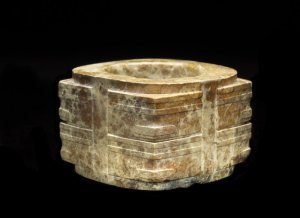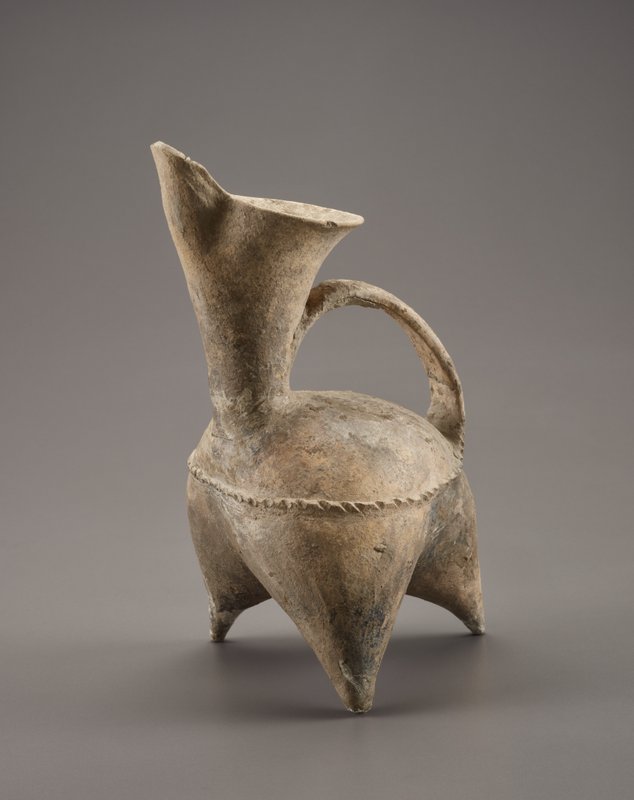 (Artist) Liangzhu culture; China; ca. 3300-2250 B.C.E.; Jade (nephrite); H x W x D: 6.5 x 9.5 x 9.4 cm (2 9/16 x 3 3/4 x 3 11/16 in) Diam (hole): 6.2 cm (2 7/16 in); Gift of Charles Lang Freer
(Artist) Liangzhu culture; China; ca. 3300-2250 B.C.E.; Jade (nephrite); H x W x D: 6.5 x 9.5 x 9.4 cm (2 9/16 x 3 3/4 x 3 11/16 in) Diam (hole): 6.2 cm (2 7/16 in); Gift of Charles Lang Freer Effective January 1, 2014, the Freer Gallery of Art and Arthur M. Sackler Gallery, both a part of the massive Smithsonian museum complex in Washington, D.C., have released their entire collections of art and artifacts for online viewing. The release provides “unprecedented access to one of the world’s most important holdings of Asian and American art,” announced gallery officials in a press release. “The free public resource—called “Open F|S”—will launch at open.asia.si.edu, allowing anyone to explore and create with the collections, from anywhere in the world.”
Most of these objects have never been seen by the public, with over 90 percent of them available in high-resolution format and without copyright restrictions, as long as they are used for non-commercial purposes, say museum officials.
This makes the Freer and Sackler galleries the first and only Asian art museums to digitize and release their entire collections to the public, joining only a few museums in the U.S. that have done similarly with other types of collections. “The public is encouraged to use the images for educational, scholarly, artistic and personal projects that will not be marketed, promoted or sold,” say museum oficials. “Enthusiasts are encouraged to provide feedback for “Open F|S” by signing up to become a beta tester for the Freer|Sackler. Beta testers who sign up will receive exclusive hackathon invitations and closed test versions of future “Open F|S” iterations.”
See examples of items available in the digital collections database below.
_________________________________
Jade (nephrite) ceremonial Tube (Cong) with masks. Late Neolithic period object dated to ca. 3300 – ca. 2250 BCE, Liangzhu Culture, China. Gift of Charles Lang Freer. Courtesy Freer Gallery of Art and Arthur M. Sackler Gallery.
___________________________________
Earthenware ceramic tripod ewer vessel of the Dawenkou culture from Shandong Province, China (ca. 4300 – ca. 2400 BCE). The Dr. Paul Singer Collection of Chinese Art of the Arthur M. Sackler Gallery, Smithsonian Institution; a joint gift of the Arthur M. Sackler Foundation, Paul Singer, the AMS Foundation for the Arts, Sciences, and Humanities, and the Children of Arthur M. Courtesy Freer Gallery of Art and Arthur M. Sackler Gallery.
___________________________________
Looking beyond this initial release, officials say that the “Open F|S” initiative will offer additional functions such as sharing, curation and community-based research, and some of the images will even be available to the public for download as free mobile backgrounds, desktop wallpapers and social media headers.
Beginning January 2, the galleries will share rarely seen curator favorites from their digital collection in a new “Friday Fave” weekly series posting on Bento, the Smithsonian museum blog.
___________________________________________
Source: Adapted and edited from information provided by a Freer/Sackler Gallery press release.
___________________________________________
Just released!
The special new premium quality print edition of Popular Archaeology Magazine. A beautiful volume for the coffee table.
Travel and learn with Far Horizons.
____________________________________________
Read about the most fascinating discoveries with a premium subscription to Popular Archaeology Magazine. Find out what Popular Archaeology Magazine is all about. AND MORE:
On the go? Get the smartphone version of Popular Archaeology as an app or as an ebook.
Popular Archaeology’s annual Discovery Edition eBook is a selection of the best stories published in Popular Archaeology Magazine in past issues, with an emphasis on some of the most significant, groundbreaking, or fascinating discoveries in the fields of archaeology and paleoanthropology and related fields. At least some of the articles have been updated or revised specifically for the Discovery edition. We can confidently say that there is no other single issue of an archaeology-related magazine, paper print or online, that contains as much major feature article content as this one. The latest issue, volume 2, has just been released. Go to the Discovery edition page for more information.











